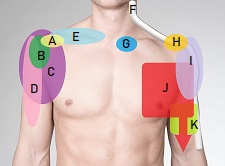- Home
- Diagnosis Guide
- Lump On Arm
- Top Of Shoulder Lump
Bump On Top Of Shoulder
Written By: Chloe Wilson BSc (Hons) Physiotherapy
Reviewed By: SPE Medical Review Board
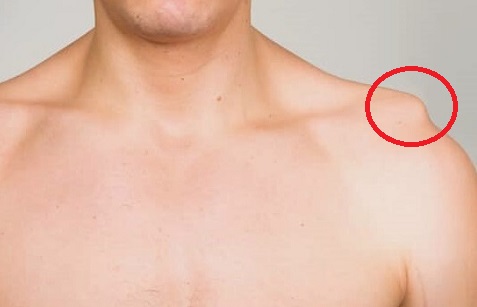
A bump on top of the shoulder is a common problem that can affect people at any age.
Shoulder lumps may vary from something simple e.g. skin lesions or muscle knots, irritation of the soft tissues e.g. bursitis or tendonitis to something more serious e.g. fractures or tumors.
A lump between the neck and shoulder may be soft or firm, mobile or fixed, vary in size and may have developed gradually or suddenly.
In most cases, a lump on top of the shoulder will settle down fairly quickly with home treatments, but some will require medical intervention such as a course of physical therapy, medication or injections. Occasionally, greater intervention may be required such as surgery but this is rare.
Here we will look at both the common and rarer causes of a bump on top of the shoulder, the common causes and symptoms of each and then go on to look at how to treat them. We will also cover how to tell if it is something serious and when to seek medical advice. If your lump is in a slightly different location, check out the shoulder lumps, lump on back of shoulder and collarbone lumps articles.
What Causes A Lump On Top Of The Shoulder?
Common causes of a bump on top of the shoulder are usually due to problems in the:
- Soft Tissues: typically inflammation, wear and tear or infection e.g. bursitis, tendonitis, cysts or skin lesions
- Bones & Joints: typically around the clavicle (collar bone) or shoulder joint e.g. fractures, dislocation or arthritis
Let's start by looking at the most common causes of lumps on top of the shoulder, what causes them and the common symptoms associated with each so you can work out what is causing your shoulder bump, and find the best treatment options.
1. Shoulder Bursitis
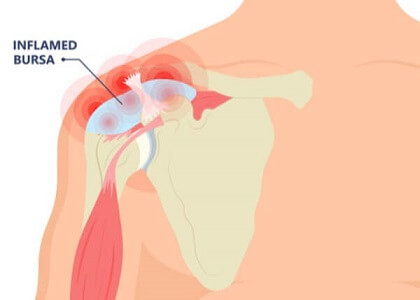
A common cause of a soft lump on top of the shoulder is bursitis.
Bursa are small fluid-filled sacs that sit between the shoulder bones and soft tissues to reduce friction at the shoulder joint. If the bursa becomes inflamed, excess fluid collects in it forming a lump which is typically soft and spongy to touch.
The most common type of shoulder bursitis that causes a bump on top of the shoulder is:
- Subacromial Bursitis: inflammation of the subacromial bursa, located just underneath the acromion – a bony projection from the shoulder blade that forms an arch over the rotator cuff tendons
The subacromial bursa often fuses with the neighbouring subdeltoid bursa, located between the acromion and the deltoid muscle on the outer shoulder. When this happens they form a single bursa, which is actually the largest bursa in the human body.
These two bursae acts as cushions between the acromion and the rotator cuff tendons, particularly supraspinatus, helping to reduce friction and facilitate smooth movement of the shoulder joint.
Common causes of shoulder bursitis include:
- Overuse or Repetitive Movements: of the shoulder joint e.g. athletes, manual laborers or individuals who perform overhead activities regularly
- Trauma or Injury: to the shoulder e.g. from a fall
- Degenerative Changes: in the shoulder joint e.g. bone spurs or arthritis which reduce the space underneath the acromion
- Muscle Imbalance: weakness and/or tightness in the shoulder muscles affects how the joint moves which can lead to friction
Symptoms of subacromial bursitis typically include:
- Pain: Persistent and often sharp pain in the shoulder, especially during overhead movements, or when lying on the affected shoulder
- Swelling: typically a small, soft lump on top of the shoulder towards the outer edge
- Limited Range of Motion: Difficulty in raising the arm or performing everyday activities that involve the shoulder
- Weakness: Reduced strength in the affected shoulder due to pain and discomfort
Treatment for shoulder bursitis usually involves conservative approaches such as rest, ice, anti-inflammatory medications, and physical therapy to reduce inflammation and improve shoulder mobility. In more severe or persistent cases, corticosteroid injections or, in rare instances, surgery to remove the inflamed bursa may be recommended.
Another type of bursitis that can result in a bump on top of the shoulder is supra-acromial bursitis - inflammation of the supra-acromial bursa when sits on top of the acromion, just underneath the skin, although this is very rare.
You can find out all about the common causes, symptoms, diagnosis and treatment options for this cause of a lump on top of the shoulder in the shoulder bursitis section.
2. ACJ Problems
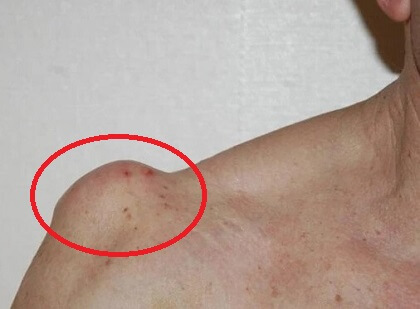
Problems at the ACJ, aka acromioclavicular joint, can lead to the development of a lump on top of the shoulder.
The acromioclavicular joint is where the outer end of the collarbone (clavicle) meets the highest point of the shoulder blade (acromion).
Several issues can affect this joint, causing changes in its appearance and function, resulting in the formation of a lump between the neck and shoulder:
- ACJ Dislocation: The most common problem to cause a bump on top of the shoulder at the ACJ is dislocation, often referred to as a separated shoulder. This occurs when the ligaments holding the clavicle and acromion together become stretched or torn due to a sudden injury or trauma e.g. fall or direct blow. The collarbone gets forced upwards or outwards, creating a noticeable lump or bump on the top of the shoulder. The severity of the dislocation can vary, leading to different degrees of prominence.
- Arthritis: Arthritis can affect the acromioclavicular joint, causing inflammation, pain, and structural changes over time. In some cases, the joint may develop osteophytes (bone spurs) or other bony growths. These abnormalities can contribute to the formation of swelling or a hard lump on top of the shoulder, as they alter the joint's shape and contours.
- ACJ Inflammation: Inflammation of the acromioclavicular joint, often due to overuse or repetitive strain can lead to localized swelling and tenderness and an AC joint bump on shoulder. This swelling may present as a soft palpable lump, especially when the joint is irritated or inflamed.
- Cysts: In some cases, chronic ACJ problems can lead to the formation of cysts or fluid-filled sacs around the joint. These cysts can cause visible swelling or a soft lump on the top of the shoulder which may be tender, particularly when they become enlarged or press against surrounding tissues.
Treatment for an AC joint bump on the shoulder may include rest, physical therapy, anti-inflammatory medications, joint injections, or, in severe cases, surgical intervention. The specific treatment approach depends on the underlying cause of the bump on top of the shoulder and the severity of the condition.
3. Shoulder Tendonitis
Another possible cause of a bump on top of the shoulder is tendonitis. There are various tendons located around the top of the shoulder that play an important role in stabilising and controlling movement at the shoulder joint.
Tendonitis occurs when a tendon becomes inflamed, irritated or thickened, often due to overuse or repetitive strain. This can lead to localised tenderness and swelling often forming a lump on top of the shoulder, particularly at the front of the joint.
The three most common types of tendonitis that can result in a bump on top of the shoulder are:
- Supraspinatus Tendonitis: Causes a painful arc with shoulder movements and pain on resisted abduction. A lump on top of the shoulder from supraspinatus tendonitis tends to be on the outer part of the shoulder just off the side or back of the acromion - the bony tip on the outer edge of the shoulder blade.
- Biceps Tendonitis: Inflammation of either the long head or short head of the biceps tendon can lead to a bump on top of the shoulder where the tendons attach to the front of the joint. There will be pain, tenderness and inflammation at the front of the shoulder, just below the front border of the acromion.
- Calcific Tendonitis: occurs when calcium deposits build up within one of shoulder tendons forming a lump on the top of the shoulder. The lump may feel hard and be associated with varying degrees of pain and discomfort.
Quick Tests For Tendonitis
If you think the bump on top of your shoulder is from tendonitis, here are a couple of simple tests you can try:
- Supraspinatus Tendonitis: Starting with your elbow at your side, try to move your upper arm out to the side, away from your body while resisting the movement with your other hand. Pain at the top of the shoulder indicates supraspinatus tendonitis
- Biceps Tendonitis: Starting with your arm at your side and your elbow bent at a right angle, try to bend your elbow while resisting the movement with your other hand. Pain at the front of your shoulder indicates biceps tendonitis
Treatment options for bumps on top of the shoulder from tendonitis may include rest, physical therapy, anti-inflammatory medications, corticosteroid injections, or in severe cases, surgical intervention to repair or remove damaged tissue.
You can find out all about the causes, symptoms, diagnosis and treatment options of lumps on top of the shoulder from tendonitis in the Supraspinatus Tendonitis and Biceps Tendonitis sections.
4. Muscle Knot
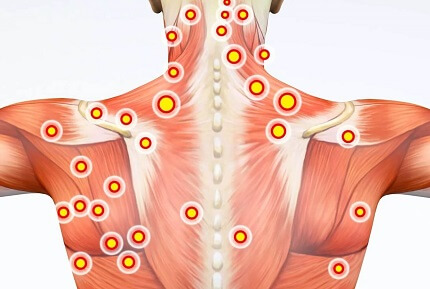
Another common cause of a bump on top of the shoulder is a muscle knot.
Muscle knots typically result from a condition known as myofascial trigger points.
These knots are tight, contracted muscle fibres that can be felt as a nodule or lump on top of the shoulder directly under the skin. They are often tender to the touch and can lead to localized pain and discomfort. A firm lump between the neck and shoulder that is in the muscle is often due to a trigger point in the trapezius muscle.
- Common Causes: Muscle knots usually develop due to excessive muscle tension or strain from various factors, including muscle overuse, trauma, poor posture, stress, or muscle imbalances. When muscles are chronically tense or strained, these knots can form leading to a lump between the neck and shoulder
- Common Symptoms: The most common symptom of muscle knots is a hard or firm, defined lump on top of the shoulder, particularly in the upper trapezius muscle. The lump often causes localized pain and tenderness. The pain may be dull, aching, or sharp, and it may worsen with movement. You may also experience limited range of motion in the affected shoulder.
Treatment for a bump of top of the shoulder from muscle knots typically involves a combination of self-care and professional interventions such as:
- Self-Massage: Gentle self-massage with your fingers or a foam roller directly over the shoulder lump can help release tension in the affected muscles
- Heat and Cold Therapy: Applying heat or cold packs can help relax muscles and reduce inflammation
- Stretching: Performing regular shoulder stretches can improve flexibility and reduce the risk of muscle knots
- Physical Therapy: A physical therapist can provide exercises and techniques to alleviate muscle knots and improve shoulder function
- Trigger Point Injections: In some cases, healthcare professionals may use trigger point injections, which involve injecting a medication directly into the knot to relieve pain and tension
Find out more about the causes, symptoms and treatment options for lumps between the neck and shoulder from trapezius muscle knots.
5. Trauma or Injury
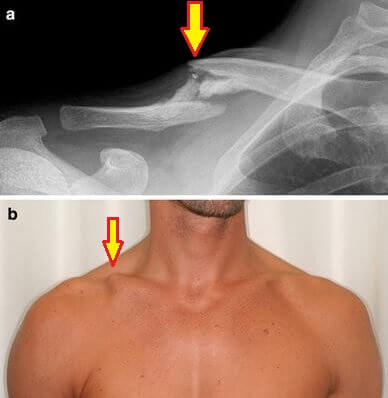
A lump on the top of the shoulder may result from an injury, such as a fall, RTA or sporting tackle.
These injuries can result bone/joint displacement, the formation of scar tissue or bony lumps at the top of the shoulder.
The size of shoulder bumps resulting from trauma or injury can vary widely, from small bruises to larger haematomas, depending on the extent of tissue damage.
Lumps and bumps from trauma are usually located at the site of the injury on the shoulder. They can feel swollen, tender, and may be associated with bruising. In some cases, there may be a visible deformity and significant pain and limitation of movement.
The most common injuries to cause a hard lump on top of the shoulder are:
- Clavicle Fractures: aka broken collarbone, causes a collar bone lump on shoulder. Particularly common in children following a fall
- Proximal Humerus Fractures: aka humeral head fractures. Particularly common in adults over 65 and often caused by a fall onto an outstretched hand
- Dislocated Shoulder: where the upper arm bone pops out of its socket at the shoulder usually following a fall or direct blow
If you experienced some trauma to your shoulder such as a fall, RTA or contact injury and there is an obvious deformity, significant bruising or swelling associated with the bump on top of your shoulder, you should seek immediate medical attention.
You can find out more about the diagnosis and treatment of shoulder injuries in the clavicle fractures and shoulder fractures sections.
Other Possible Causes Of A Bump On Top Of The Shoulder
There are a number of other possible causes of a lump on top of the shoulder, but they tend to be less common:
1. Ganglion Cyst
A lump under the skin on the shoulder is often caused by a ganglion cyst. Ganglion cysts are non-cancerous lumps filled with a thick jelly-like substance. A lump on top of the shoulder from a ganglion cyst is usually found near the acromioclavicular joint. Ganglion bumps can vary in size but are usually small, typically less than an inch (2.5cm) in diameter.
Ganglion cysts usually feel smooth, round and firm, and they can move slightly when pressed. They are often painless but may cause discomfort if they press on nearby structures. Find out more >
2. Enlarged Lymph Node
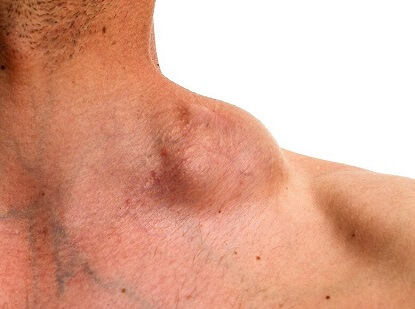
Lymph nodes are part of the immune system and can become enlarged, known as lymphadenopathy. This can occur in response to infection or inflammation in the surrounding area.
Infections or inflammatory conditions in the shoulder, neck, head or upper chest regions can lead to enlarged lymph nodes which may present as small, soft moveable lumps on top of the shoulder that can be felt just beneath the skin. Enlarged lymph nodes can vary in size from pea-sized to a centimetre or more in diameter. They tend to feel rubbery or slightly firm and may be tender or painless, depending on the cause.
3. Skin Lesions
Skin conditions like moles, warts, or cysts can occur anywhere on the top of the shoulder. The size of skin lesion lumps on top of the shoulder can vary widely.
- Moles: may be small to medium-sized and are typically flat or slightly raised with a uniform color. They can be smooth or rough
- Warts: can be tiny or larger lumps on top of the shoulder and often have a rough texture and a cauliflower-like appearance
- Keratosis Pilaris: Clusters of small white or red lumps that typically form on the side and back of the upper arm
- Epidermoid Cysts: can range from a few millimetres to several centimetres. They typically feel like soft but firm, round movable lumps on top of the shoulder, just beneath the skin
- Sebaceous Cyst: a type of cyst that forms when a hair follicle becomes blocked and oil and skin cells accumulate. These cysts are filled with a thick, cheesy substance called sebum and result in a lump under the skin on shoulder
4. Tumors
Although a cancer lump on shoulder is fairly rare, malignant tumors or cancerous growths can develop in the soft tissues around the shoulder, causing a lump on top of the shoulder or around the shoulder blade. Sarcomas, for example, are a group of rare cancers that can affect the shoulder region.
Tumor lumps can vary greatly in size from small nodules to larger masses. They typically feel firm and solid. Cancerous tumors may be painless or cause discomfort, depending on their type, size and stage. There are often other symptoms associated with a cancer lump on the shoulder such as fatigue, unexplained weight loss and night pain.
5. Infections
In rare cases, infections in the skin or deeper tissues of the shoulder can result in the formation of a lump on top of the shoulder, particularly near one of the joints or in areas of broken skin.
A bump on top of the shoulder from an infection may be warm, tender and red, and you may experience a fever. The lump may be firm and fixed or soft and moveable. In some cases, the lump may contain pus, particularly with bacterial infections e.g. abscesses. The size of top of shoulder lumps from infections will vary depending on the severity and extent of the infection
6. Lipoma
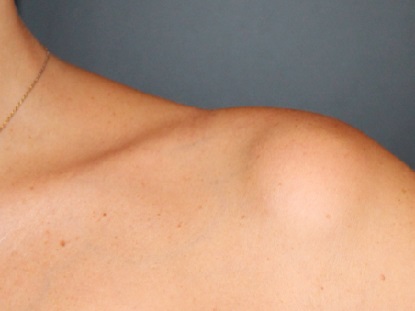
Lipomas are benign, i.e. non-cancerous fatty tumors that can develop beneath the skin.
They are typically soft, rubbery, mobile, and painless, unless they are pressing on nearby structures.
Lipoma lumps on top of the shoulder are usually well-defined and slow growing. They can vary in size but are usually less than 2 inches wide. Lipomas tend to be round or oval shaped and are particularly common in adults aged 40-60.
In most cases, shoulder lipomas don't require any treatment but they can be removed surgically if they start causing symptoms or for cosmetic reasons.
7. Rheumatoid Nodules
Rheumatoid arthritis (RA) is an autoimmune disorder where the body's immune system targets the synovium, the lining of joints. This condition can lead to the formation of firm nodules on different areas of the body, particularly the hands and arms and can result in lumps on top of the shoulder. The nodules are typically made up of fibrin (a protein associated with blood clotting), inflammatory cells and dead skin cells.
Rheumatoid nodules are typically quite small, ranging from pea-sized to walnut-sized. They are usually firm and immobile and while the lumps are often painless, there may be associated joint pain. The lumps may occur in isolation or in clusters.
Diagnosing Lumps Between Neck And Shoulder
Any new bump on top of the shoulder should be checked out by your doctor to make sure you get the right diagnosis.
A doctor can often identify the cause of the lump on top of your shoulder through your medical history and a visual examination. However, in certain situations, they might recommend additional tests like X-rays, MRI scans, CT scans, or a biopsy to gather more information.
Treatment for a lump between the neck and shoulder will vary depending on the underlying cause but may involve a combination of strengthening exercises, stability exercises, stretches, medication, steroid injections and occasionally surgery.
You can find out more about the best treatment options for the different causes of lumps on top of the shoulder:
- Shoulder Bursitis Treatment
- Supraspinatus Tendonitis Treatment
- Biceps Tendonitis Treatment
- Clavicle Fracture Treatment
- Shoulder Fracture Treatment
Bump On Top Of Shoulder Summary
There are lots of possible causes of a lump on top of the shoulder:
A hard lump on top of shoulder might be due to a fracture, dislocation, bone spur, calcific tendonitis, muscle knot or arthritis
A soft bump above the shoulder is usually caused by bursitis, a cyst or a lipoma
A painful lump on the shoulder can be due to supraspinatus tendonitis, biceps tendonitis, muscle knot, fracture, bursitis or an infection
A lump under skin on shoulder is likely due to a cyst, enlarged lymph node, lipoma, acne, or keratosis pilaris
A small lump on the shoulder may be from bursitis, muscle knot, cysts, tumor, enlarged lymph node or lipoma
A large bump on the shoulder may be due to a displaced fracture, large cyst, tumor or lipoma
A cancer lump on the shoulder is often firm, non-mobile, grows rapidly, irregularly shaped, accompanied by other symptoms e.g. unexplained weight-loss, night pain and fatigue.
You may also be interested in the following articles:
- Front Shoulder Pain
- Shoulder Pain Diagnosis Chart
- Upper Arm Pain
- Elbow Pain Diagnosis
- Shoulder Exercises
- Shoulder Lumps & Bumps
- Lump On Collarbone
- Lump On Back Of Shoulder
Page Last Updated: 03/05/2024
Next Review Due: 03/05/2026

